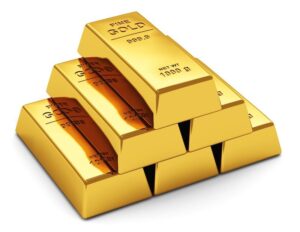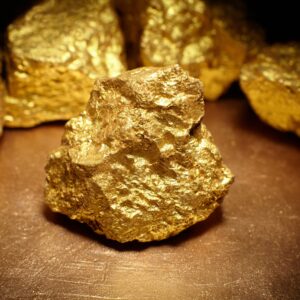Our Gold
Atomic number: 79
Atomic weight: 196.967
Melting point: 1,064 degrees C
Specific gravity: 19.3 when pure
Hardness: 2.5–3
Gold is 19.3 times heavier than an equal volume of water. It’s rare, soft and unreactive.
What Is Gold?
Gold is a rare metal. Its chemical symbol is Au, named after Aurora, the Roman goddess of the dawn. The purity of gold is described by its “fineness” in parts per 1,000 or by the carat scale, which is parts per 24. The word “carat” derives from the Italian carato, Arabic qirat or Greek keration, all meaning the fruit of the carob tree. Ancient traders used carob seeds as the means to balance the scales in oriental bazaars. Pure gold is 24 carats or 1,000 fine.
The price of gold and other precious metals is quoted in terms of troy ounces. The term “troy” is derived from Troyes, France, a major trading city of the Middle Ages. One troy ounce equals 31.1 grams.
What Are the Properties of Gold?
Pure gold is soft and wears easily. It is often mixed with other, harder metals. A mixture of metals is called an alloy. Gold is very unreactive. This means it is resistant to corrosion and tarnishing. That is why a gold nugget can be buried in the ground for thousands of years and still come up looking shiny.
Gold is malleable (easily shaped) and ductile (can be drawn into very thin wire). A square lump of gold about the size of your thumbnail would weigh an ounce. That ounce of gold can be flattened into a sheet so thin that it would be thinner than a piece of tissue paper, and light could pass through it. It would cover an area about the size of a small bedroom. The same lump of gold can be drawn into a piece of wire 80 km long. That’s long enough to go around a rugby field 23 times.
Where Is Gold Found?
Gold is found as a free metal in nature. It can be found as nuggets or bound up with rock and is too small to see with the naked eye. It is sometimes found in association with other metals.
What Has Gold Been Used for in the Past?
Gold has been used for ornaments and decoration and as money for over 5,000 years. Gold leaf has been used for the decoration of tombs and statues, cathedrals and temples, fine books, and picture frames since Egyptian times. Many Egyptian burial cases, including King Tutankhamun’s (1352 BC), were gilded with beaten gold. Gold leaf is still often preferred for adorning the domes or ceilings of buildings (such as the Metropolitan Opera House in New York) because its resistance to corrosion means that it will outlast paint by many years.
Gold was made into jewelry long before it was used as currency. The earliest gold jewelry dates from the Sumeric civilization around 3,000 BC. The jewelry was worn by both men and women. Goldsmith’s skills that were understood and mastered at that time are still used today, although some of the techniques have been lost. Gold wedding rings, used in marriage ceremonies since the ninth century, date back to the ancient Egyptian times. The ring is placed on the third finger of the left hand because it was believed that this finger carried an artery leading directly to the heart.
Gold Uses Today
Besides being a currency, gold has many uses, including:
many uses, including:
Decoration: Gold has been used for ornaments and decoration for more than 5,000 years – Its resistance to corrosion helps it outlast paint
Jewelry: Gold has been used in jewelry since as early as 3,000 BC
Gold-reflective glass – Gold reflects heat and is so malleable that it is used to coat glass with a thin film, which lets through light, but not heat – The use of reflective glass has reduced cooling and heating costs by as much as 40 percent in some buildings
Electronics – Gold is a very good conductor of electricity, and it doesn’t corrode or tarnish at high or low temperatures – It is used in circuits in calculators, television sets, computers, telephones and other electronics
Satellites and Communications – Gold is used in satellites as part of their electronic circuits and as a heat shield
Aerospace: Because the metal reflects heat, gold is used to protect astronauts, satellites and critical electronic components from damage by hazardous X-rays and solar radiation found in space
Medicine: Radioactive gold is used to treat several types of cancer – Gold leaf is used to treat chronic ulcers and is used in surgery to patch damaged blood vessels, nerves, bones and membranes
Dentistry: Each year, U.S. dentists alone use about 30 tons of gold for crowns, bridges, gold inlays and dentures because of their high resistance to corrosion and tarnish
